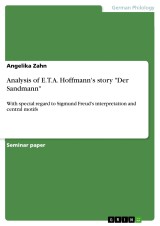Details

Analysis of E.T.A. Hoffmann's story "Der Sandmann"
With special regard to Sigmund Freud's interpretation and central motifs1. Auflage
|
15,99 € |
|
| Verlag: | Grin Verlag |
| Format: | |
| Veröffentl.: | 27.01.2022 |
| ISBN/EAN: | 9783346580153 |
| Sprache: | englisch |
| Anzahl Seiten: | 24 |
Dieses eBook erhalten Sie ohne Kopierschutz.
Beschreibungen
Seminar paper from the year 2005 in the subject German Studies - Modern German Literature, grade: 1,0, University of Regensburg, language: English, abstract: The story "The Sandman" by E.T.A. Hoffmann appeared in 1816 in the first part of the story cycle "Nachtstücke". Throughout the cycle, the typical Romantic interest in the night side of nature, in the uncanny, the morbid and the criminal, prevails. "The Sandman" is the most famous story in the collection. It is about the student Nathanael who, already engaged to the bourgeois girl Clara, falls in love with the daughter of a professor, the beautiful Olimpia, at his place of study, until it turns out that she is not human but an automaton. This deception, and also the repeated confrontation with the horror of his childhood, the Sandman, threatens his identity to such an extent that it drives him to madness and finally to death.
Probably the best-known analysis of the "Sandman" was written by Sigmund Freud in 1919 in his study of the uncanny, and here he relates the fear of eye-snatching to the fear of castration. The discussion that grew out of this makes Hoffmann's first night play one of his most discussed narratives, which has been taken up again and again by many interpreters of different scientific theoretical orientations.
This essay by Freud, as well as various other interpretive approaches, will now be discussed in more detail here. In addition, the central motifs which permeate the narrative and which occur in an extraordinary density will be closely examined and some thematic aspects, such as the automaton motif and the artist problem, will be presented. A comparison will also be made with Todorov's definition of fantasy.
Probably the best-known analysis of the "Sandman" was written by Sigmund Freud in 1919 in his study of the uncanny, and here he relates the fear of eye-snatching to the fear of castration. The discussion that grew out of this makes Hoffmann's first night play one of his most discussed narratives, which has been taken up again and again by many interpreters of different scientific theoretical orientations.
This essay by Freud, as well as various other interpretive approaches, will now be discussed in more detail here. In addition, the central motifs which permeate the narrative and which occur in an extraordinary density will be closely examined and some thematic aspects, such as the automaton motif and the artist problem, will be presented. A comparison will also be made with Todorov's definition of fantasy.
Diese Produkte könnten Sie auch interessieren:

Wie aktuell ist Erich Kästners Buch „Das doppelte Lottchen“ im Hinblick auf Geschlechterkonstruktionen und -rollen?

von: Lena Marie Ostermann

13,99 €















